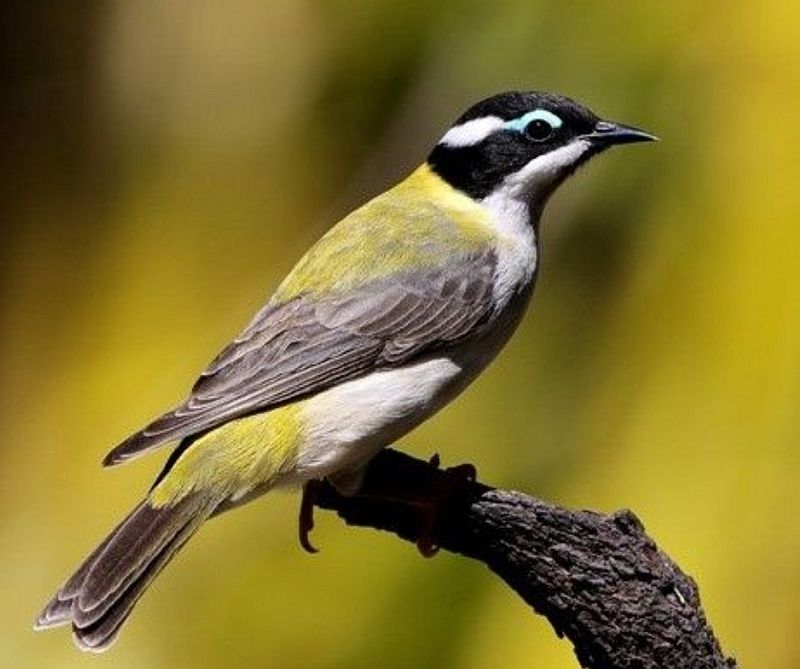Family: The black-chinned honeyeater (Melithreptus gularis) belongs to the family Meliphagidae, a member of the genus Melithreptus
Habitat: Temperate and subtropical/tropical dry forests are their native habitats. The black-chinned honeyeater is one of a small natural group of honeyeaters with a black head, a white crescent around the nape, and a spot of colored bare skin above the eye. They are grouped in the genus Melithreptus. All have short, wedge-shaped bills and spend much more of their time gleaning in foliage and on tree branches than in rifling blossom for nectar. This honeyeater is frequently observed along streams, particularly in arid and semi-arid regions. It is also sporadically observed in street trees and gardens.
Behavior: The black-chinned honeyeater should not be confused with the white-throated honeyeater, white-naped honeyeater, and brown-headed honeyeater, which are related. The black-chinned honeyeater is the most sedentary of the group and lives in the smallest communes of two to 10 birds, rarely more. But because the feeding territory of each colony is so large, the birds often appear to be locally nomadic.
Their colonies are thinly distributed around the drier open eucalypt woodlands of the Australian mainland, mainly along the western slopes of the Great Dividing Range and across the mid-north, where they range into spinifex scrubs. Like the more nomadic Brown-headed Honeyeater of denser scrubs, the Black-chinned move around quickly from tree to tree, mostly eucalypts, foraging rapidly along outer twigs, the underside of branches, and even trunks, probing in crannies and under bark for insects.
In summer, a lot of honeydew is also harvested from foliage; the birds maintain contact by calling frequently and disrupting their pattern of drinking and bathing during the day. Breeding can be communal, with additional members of the colony helping the senior parental pair feed their young. The Black-chinned Honeyeater lives in open eucalypt woodland in northern and eastern Australia.
Vocalizations: Black-chinned Honeyeater call is usually high-pitched bubbling croaks prrrrp, prrrrp, often in concert among groups and in flight, for contact. The song is a bubbling trill, ch-reeee, ch-reeee, repeated several times and often developing out of prrrrps in a duet but usually given by only one bird, from a vantage perch; sometimes between individuals when landing from the flight.
Identification: Adults: Sexes similar. Head black to sides of cheeks, with a white band around nape to eyes. Back and rump dull olive green to rich lemon-yellow across northern Australia, varying according to race; wings and tail mid-grey-brown washed lightly with citrine. Chin black, running onto the center of the upper throat; lower cheeks and malar sash white. The rest of the underparts are white, with a grey bloom in the eastern race. Eyes are deep brown, with a spot of bare skin above the eye turquoise-blue in the eastern race and turquoise-green-toned yellow in northern race. The bill is black, and the feet are fleshy brown. The immature (As adult) crown is dusky brown, the nape band buff-white, the eye skin dull grey, and the bill dull buff
Nesting and Breeding: Black-chinned honeyeater nesting and breeding occur in July–December. Nest a deep, beautiful felt-like cup, of strips of grass and bark closely bound with down and cobweb; lined with plant down; suspended from the rim in ends of hanging leafy branchlets, at 3–5 meters above ground.
Eggs: This bird lays one to two eggs: salmon-pink, spotted sparsely with rich chestnut, red-brown, mostly at the larger end; oval, about 22 x 16 mm. The incubation period is about 14–15 days. Young fledge in 13–14 days.
Distribution: black-chinned honeyeater is open eucalypt woodland and/or ringing forest and desert scrub, mainly along the western slopes of the Great Dividing Range and across near inland north to Pilbara, Western Australia. Small, declining outlying population in Mt Lofty Ranges, South Australia. On the western end of the Einasleigh Uplands, especially in the vicinity of the Newcastle and Gregory Ranges, the species is absent from the savanna. It is found throughout the Northern Territory’s Top End, but not in Arnhem Land in the vicinity of Darwin. It is also widely distributed further south, reaching roughly 21° S.
Taxonomy: John Gould originally identified the black-chinned honeyeater as Haematops gularis in 1837. However, in 1875, he also named the golden-backed honeyeater (Melithreptus laetior) that he believed to be found in northern Australia. The brown-headed and similarly plumed strong-billed honeyeaters are most closely related to the black-chinned honeyeater, which shares several species of similar size and molecular markers. Both species belong to the subgenus Eidopsarus; they are characterized by short, sturdy feet, smaller flock sizes, more forested habitat than the other subgenus, and a preference for probing for insects on branches and bark as opposed to foliage.
Diet: The primary food source is insects, which graze by making holes in the bark of tree trunks and branches.
Movements: Moreover, the local migrations connected to food plants blossom; in certain places, these movements are seasonal and may be seen as nomadic.
Other Names: The bird is also known as Golden-backed Honeyeater and Black-throated Honeyeater.
Size: Black-chinned Honeyeater measures about 155-170 mm.
Status and Threats: The status is the least concern on the IUNCN red list. However, due to habitat loss and habitat fragmentation of productive soils in landscapes preferred for farming, the black-chinned honeyeater is declining over most of its spectrum. However, further research is needed to determine the potential effects of the changing climate on the black-chinned honeyeater as well as the ability of the subspecies to adapt.
Read More: Eungella Honeyeater (Bolemoreus hindwoodi)









